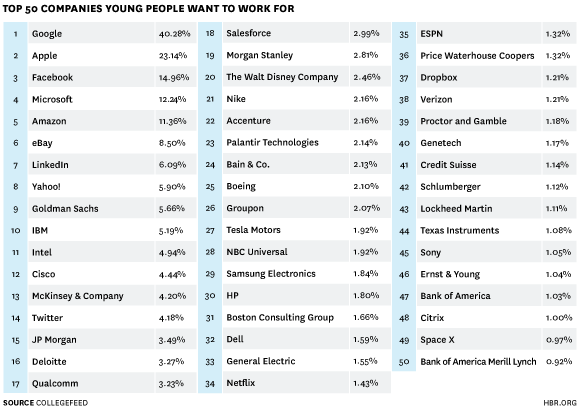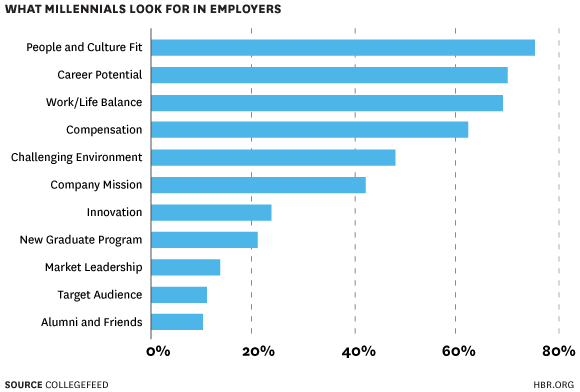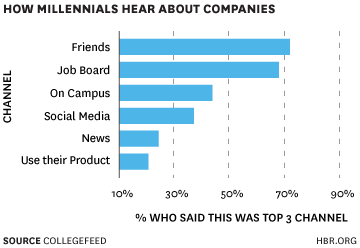The following post was written by and being reposted with permission from Sanjeev Agrawal, CEO and co-founder of Collegefeed. View the original post on HBR.org.
Over the past year, my firm Collegefeed met with more than 300 companies to understand their college hiring strategies and tactics — from employers with large university hiring infrastructures to recently funded start-ups looking to hire fresh grads, interns, and young alum.
Not surprisingly, 84% understand that college hiring is important. Yet almost all agree that it’s really hard to attract good college talent. In fact, 92% believe they have a “brand problem” when it comes to their efforts; this problem is often expressed as the fact that “not everyone can be an employer like Facebook.” In other words, large, well-established companies feel they simply can’t be the newest thing out there generating buzz with Millennials.
To understand more about this underlying “brand problem,” and what employers can do about it, we polled 15,000 Millennials — 60 percent still in college and 40 percent recent graduates.* We asked them:
- What are the top three companies you want to work for?
- What are the top three things you look for when considering an employer?
- How do you generally discover companies and create an impression about them (social media, product usage, campus events, other ways)?
Here’s how they responded:
Question 1:
Respondents had to type in and enter a name here, not select from a displayed list, which eliminates the pagination bias. That said, the top 10 in this list are not surprising at all: They are well-known brands that frequently appear in the “best places to work” lists.
But what’s noteworthy is the absence of well-known consumer brands such as Coca Cola. It’s also interesting that companies like Salesforce.com and Qualcomm, which most college students don’t use, appear so high.
Question 2:
Given the first chart, you might expect things like “company mission” or “market leadership” to be on top. However “people and culture fit” is number one, followed by “career potential.” We expected “compensation” to be within the top five, but were somewhat surprised that it was only ranked fourth.
This data leaves one key takeaway: It is imperative to focus on communicating your culture and career growth to potential employees. The two fundamental questions that young job seekers ask, and that companies need to answer are: “What is it like to work there?” and “What kind of growth can I expect?”
Question 3:
These results blew us away. Most companies (almost 100% of the large ones we spoke to) say that they have an on-campus recruiting plan and that is where they focus their sourcing and branding efforts. Many also have dedicated organizations to build relationships on campus. According to a 2013 NACE study, 98.1% of companies they polled believe that on-campus fairs are the number one avenue for them to brand themselves with students.
However, this may not be the case. “Friends” showed up as the number one way Millennials hear about companies, according to our research, followed by job boards. You might also expect to see “Use their products every day” among the top five, but it showed up sixth.
Clearly, branding — how a company is perceived year round, across media types — is more important than just being present on campus. If college students like something, they tell their friends on social media or face-to-face.
So whether you sell ads, insurance, food, or routers, building a brand among college grads is about getting your story out. Sure, some companies have the basic advantage of “being among the top products students use daily” or “building the next big mobile app,” but you can also attract great talent by telling your story right – using language that Millennials relate to at places they frequent.
Here are the four most critical things you should do to improve your brand and attract the best college talent:
1. Get Your Best People to Engage With Students
Even if you are a company whose products never really get used directly by end users (think Salesforce.com, Qualcomm, Ciena, Cisco) you can still show off your employees and organizational culture to send a simple but powerful message to students: “If you come work for us, you will get to work with awesome people like these.”
So if you go to campus, bring your best recent college hires along. Showcase the work interns, young alums, and others have done, and highlight the responsibilities they have been given. If scheduling the best people or alums is hard, or if you find the attendance of physical events is low, host virtual info sessions, another easy and scalable way to reach lots of great college talent.
In addition, some leading companies we spoke to set quarterly goals for managers to hire and spend time with potential hires from colleges, whether it’s attending career fairs or answering questions on Quora or blogging about their experiences. And this leads to another important thing you can do to attract college talent.
2. Go Where Students Are (and They’re Often Not at College Fairs)
Students are online all the time. Invest in a visually appealing, content rich site where students can go to and learn about your company. If you can, personalize the site to showcase the right alums, intern experiences, and the basic messages you want to deliver to potential hires. Done right, a good “brand page” can have the same effect as a great conversation at a career fair — it’s the story of your mission, your culture and why they should join you.
Next, use social media smartly. College students spend two to four hours daily on sites like Facebook and Twitter. If you can target them based on specific interests, who they follow, and what they are searching for or talking about, real-time engagement can be quite powerful. Depending on the type of talent you are targeting, sites like Quora and other more technical ones like Hacker News can be good places to establish your brand. Similarly, if targeting a broader audience, you can go far by using humor to engage students in entertainment properties like Reddit, BuzzFeed, and CollegeHumor — people share what they find funny.
One caveat across social media in general: most online communities don’t like being marketed to, so be authentic, add value to users, and be cautious of blatant self-promotion.
3. Make the Application Process Easy and Engaging
A complicated, multiple-page application form isn’t going to cut it anymore. For Millennials (and anyone else, really), the process should be easy and frictionless.
In addition, you can’t always wait for students to come to you. After connecting with a student at a career fair or online, it’s important to go back to them and encourage them to apply when they are ready.
Another engagement strategy leading companies have found is to pique student’s interests by holding online contests and activities that paint an interesting picture of their brand. Google, Microsoft and several other companies do this programmatically.
4. Prioritize Meaning Over Swag
Too many companies are focused on giving away swag, under the perception that free stuff gets eyeballs. But Millennials are more interested in identifying with your mission than they are in a free T-shirt. If you want their mindshare you have to go beyond swag, and that concept should extend beyond career fairs to everything they read and hear about you.
Are you securing people’s futures? Are you making the world green? Are you making life simpler for small and medium businesses? Whatever you do, you should be able to get the message out online — in a 20 or 30 second video. The U.S. Army’s age-old recruiting video is still a great example – it really makes you want to apply.
If you get meaning right, it won’t just be you doing the talking. Social referrals have incredible power in the college context, and we’re not talking about the “refer a friend, get $5″ model. It comes down to whether a student genuinely likes who you are, what you do, and what you stand for.
*Of the responses received, 65 percent are in college and 35 percent recently graduated. 60 percent were male and 40 percent female. 50 percent were tech-oriented majors and 50 percent non-tech.




